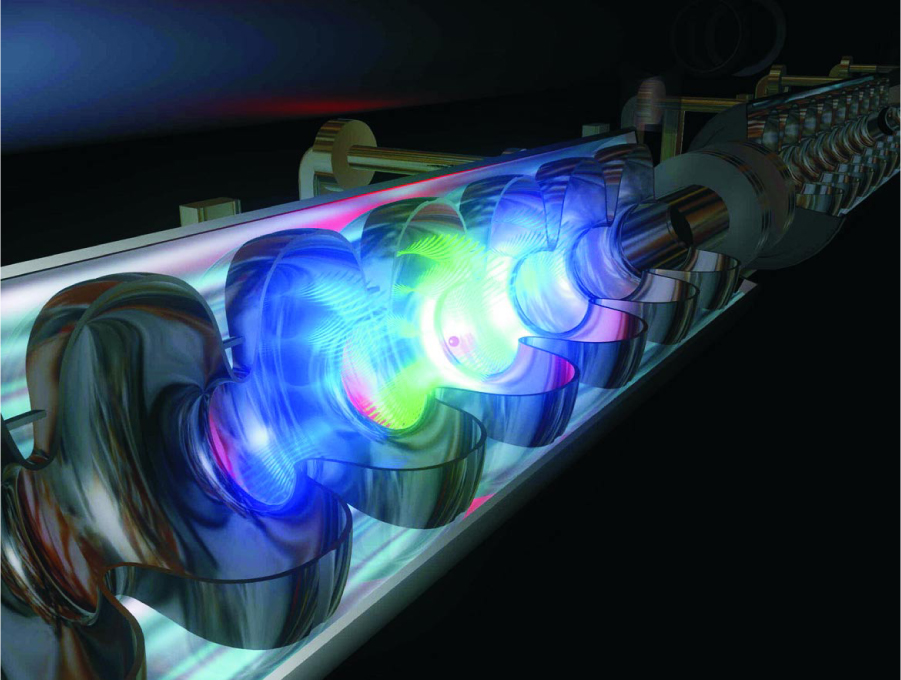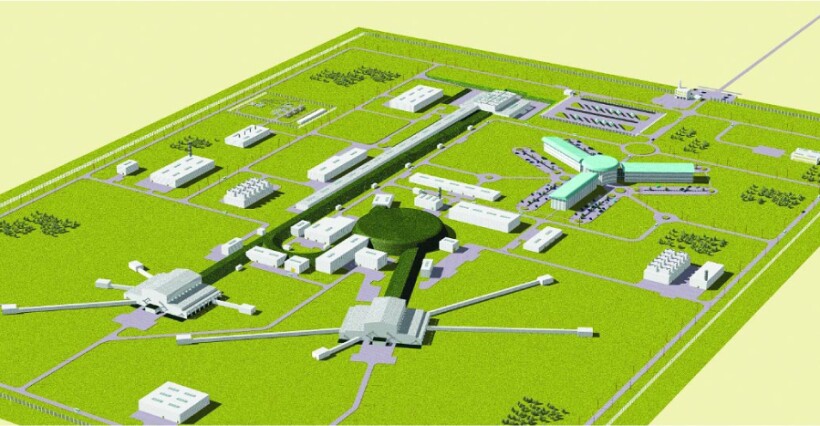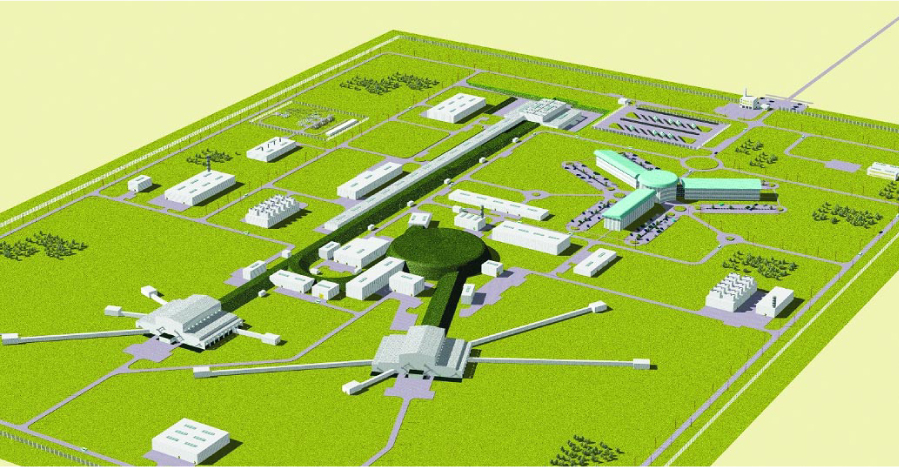Germany Reviews Big Physics Projects, Triggers Furor over Spallation Source
DOI: 10.1063/1.1534999
With one exception, an assessment of large research facilities was met this past summer with the respect that Germany’s highly regarded Wissenschaftsrat, or national science council, is accustomed to. Not so with the European Spallation Source. In that case, the ensuing quarrel between the science council and many of the experts it had appointed to review the ESS made headlines in German newspapers. The experts have not retracted their claims that the ESS review process was flawed, but now the project’s planners are focusing on bolstering their scientific case in the hopes of winning the science council’s endorsement on appeal.
Unable to fund all the emerging major research facilities, Germany’s research ministry asked for an assessment by the science council, a body of natural and social scientists, humanities scholars, and politicians that advises the state and federal governments on education and research matters. The resulting assessment encompassed nine proposed facilities that span a broad range of physics-related fields; are at various stages of technical and design readiness; include national, European, and global collaborations; and carry price tags from €25 million up to € 3.5 billion—for a combined cost of nearly €7 billion (the euro and the US dollar are roughly equal in value).
After an evaluation period that lasted just under two years, the science council grouped the projects into three categories (see the table at right). Two—the High Field Laboratory Dresden (HLD) and the High Altitude and Long Range Research Aircraft (HALO)—sailed through with flying colors. Three received conditional endorsement—the TeV-Energy Superconducting Linear Accelerator (TESLA) and the TESLA X-ray Free Electron Laser (TESLA X-FEL) at the German Electron Synchrotron (DESY) in Hamburg and an accelerator facility for beams of ions and antiprotons at the Heavy Ion Research Center in Darmstadt. And four, for various reasons, were deemed not ready to proceed. In addition to the ESS, this last category includes a soft x-ray free electron laser at Berlin’s synchrotron lab BESSY, the research ship Aurora Borealis , and a high magnetic field facility for neutron scattering at the Hahn–Meitner Institute in Berlin. Without the science council’s endorsement, the projects under consideration would not get money from the German government.
Collider contender
By far the costliest of the projects is TESLA, a contender to become the next accelerator after the Large Hadron Collider, a proton–proton smasher under construction at CERN near Geneva, Switzerland. With the LHC, particle physicists expect to glimpse the Higgs boson; with the LHC’s successor, they hope to probe the mechanisms by which the Higgs endows other particles with mass. The two machines would also search for different supersymmetric particles.
| Estimated investment cost (running cost/yr), in millions of € | Planned construction period, in years | Funding model | |
|---|---|---|---|
| Group 1 | |||
| High Field Laboratory Dresden (HLD) | 25 (3.7) | 4 | national |
| High Altitude and Long Range Research Aircraft (HALO) | 97 (3.8) | 3 | national |
| Group 2 | |||
| TeV-Energy Superconducting Linear Accelerator (TESLA) | 3450 (135) | 8 | international |
| TESLA X-ray Free Electron Laser (TESLA X-FEL) | 673 (36.1) | 8 | European |
| International Accelerator Facility for Beams of Ions and Antiprotons | 675 (79) | 7 | European |
| Group 3 | |||
| Soft X-ray Free Electron Laser (Soft X-ray-FEL) | 148 (12.4) | 4 | national |
| European Spallation Source (ESS) | 1390 (144) | 7 | European |
| High Magnetic Field Facility for Neutron Scattering Research | 49 (4.3) | 3 | national |
| European Drilling Research Icebreaker ( Aurora Borealis ) | 250 (10–15) | 4 | European |
Group 1 |
|||
High Field Laboratory Dresden (HLD) |
25 (3.7) |
4 |
national |
High Altitude and Long Range Research Aircraft (HALO) |
97 (3.8) |
3 |
national |
Group 2 |
|||
TeV-Energy Superconducting Linear Accelerator (TESLA) |
3450 (135) |
8 |
international |
TESLA X-ray Free Electron Laser (TESLA X-FEL) |
673 (36.1) |
8 |
European |
International Accelerator Facility for Beams of Ions and Antiprotons |
675 (79) |
7 |
European |
Group 3 |
|||
Soft X-ray Free Electron Laser (Soft X-ray-FEL) |
148 (12.4) |
4 |
national |
European Spallation Source (ESS) |
1390 (144) |
7 |
European |
High Magnetic Field Facility for Neutron Scattering Research |
49 (4.3) |
3 |
national |
European Drilling Research Icebreaker ( Aurora Borealis ) |
250 (10–15) |
4 |
European |
The international particle physics community agrees that the next accelerator should be an electron–positron collider. But it has not yet decided whether to go with the TESLA design, which features 33 km of superconducting accelerator, or with the normally conducting design favored in the US and Japan. Like its rival, TESLA would start out producing 500-GeV collisions and could be upgraded to higher energies. “The technical details are not all agreed. And the site decision we leave for the politicians,” says DESY Director Albrecht Wagner. What’s needed, he adds, “is some kind of symmetry breaking to make the process advance.” TESLA proponents hope the science council’s praise will do just that. “It signals that Germany makes a step forward. It could stimulate a much deeper position of the US and Asian possibilities—whether they join us or bid against us,” says Wagner. The science council said that the financial and other details of TESLA’s international collaboration should be worked out before the German government commits money to the project.
Hanging over the next-generation accelerator are the shadows cast by the LHC’s fiscal fiasco (see Physics Today, August 2002, page 26
As for the free electron laser proposed by DESY, the science council gave it good marks, but asked DESY to decouple it from TESLA. “The homework we have for the laser is to provide a technical design for a separate, smaller accelerator,” says Wagner. This decoupling opens the door for building the free electron laser even if the electron–positron collider is delayed or ditched. The science council also asked DESY and BESSY to work together to strengthen the scientific case for building two free electron lasers. Both would be used for materials studies, but they would probe at different wavelengths: The hard x rays of the TESLA X-FEL would be used to obtain atomic space and time scale information, while the BESSY Soft X-ray-FEL would probe electronic structure and function.
BESSY’s proposed free electron laser earned a come-back-when-you’re-ready rating, but the lab’s technical director, Eberhard Jaeschke, is delighted. “We decided to jump into this competition even though we didn’t yet have a detailed design report; it will be produced by early 2004,” he says. “What we could hope for was that the science case would be evaluated, and we came out brilliantly.”
100-tesla magnet lab
Thanks to the science council’s nod, Dresden is poised to take a leading role in magnetic field research in Europe, something that few scientists would have predicted a few years ago. In 1998, when the European Science Foundation published a study promoting the building of a 100-T facility as the hub of a network of magnetic field facilities, the independent HLD proposal was not taken very seriously outside of Dresden (see Physics Today, February 1999, page 59
The HLD will produce magnetic fields of up to 100 T in pulses of 10–20 ms to study material properties. Probably the best-known discoveries using strong magnetic fields are the quantum Hall effect and the fractional quantum Hall effect, which each led to a Nobel Prize. Complementing the high field lab will be an infrared free electron laser, which is due to start up next year. The combination of these instruments will be particularly important for studies in condensed matter physics, semiconductor physics, and superconductivity, says Frank Pobell, director of the Rossendorf Research Center, the leader of five institutions in and around Dresden that will jointly run the HLD.
Most of the HLD design has been ready for several years, but funding hinged on winning the science council’s approval, says Pobell. “Both the federal science ministry as well as the science ministry of Saxony have confirmed recently their former statements that they will finance the HLD if the Wissenschaftsrat gives it a positive evaluation.” Groundbreaking for the facility, he adds, will take place early next year, and the HLD is slated to start up in 2006.
Spallation setback?
Far from winning a ticket to success, the ESS may instead suffer a severe setback because of the science council’s lukewarm assessment of the project, say neutron scatterers both inside and outside Germany. Not only is the science council’s viewpoint wrong-headed, say 7 of the 11 scientists who served on the reviewing subcommittee, but it does not reflect the subcommittee’s opinions.
Two comments in the science council’s assessment aroused particular ire. One questions whether neutron scattering will still be in demand in a few years, when the ESS would come on line. The other suggests that some ESS science could be done more cheaply using synchrotron radiation, nuclear magnetic resonance, optical spectroscopy, and computer simulations.
“Basically,” says subcommittee member Bernhard Keimer of the Max Planck Institute for Solid State Research in Stuttgart, “the Wissenschaftsrat ignored the positive recommendations and blew up minor points that gave everyone the impression that the science to be done with neutrons with the next-generation facility could also be done with other techniques that are an order of magnitude cheaper. That was a misrepresentation.”
It’s fine to give valid reasons for rejecting one of these projects, Keimer adds. “The trouble starts when you give scientifically invalid reasons.” Thomas Mason, director of the Spallation Neutron Source (SNS) being built at Oak Ridge National Laboratory and a member of the subcommittee, agrees: “The Wissenschaftsrat is evaluating a lot, and they could disagree with us. But it’s not fair to distort what we said.”
The science council’s assessment of the ESS flies in the face of world opinion, says ESS chair Peter Tindemans, an independent science policy expert in the Hague, the Netherlands. He points to the 1999 recommendations of the Organisation for Economic Cooperation and Development’s Megascience Forum that existing facilities be upgraded and more powerful ones be built in Europe, the US, and Asia. Europe is currently the recognized world leader in neutron scattering. But, says Mason, “their position could be eroded if you look forward. Japan and the US have gotten to work on megawatt spallation sources, which will leapfrog anything that currently exists.”
The ESS design includes two 5-MW stations. “The ESS will have long pulses and very high intensity,” says ESS science director Dieter Richter of the Research Center Jülich. “It will be an order of magnitude better [than other next-generation neutron sources] in the crucial area of cold neutrons—like in small angle scattering, neutron spin echo, and reflectometry.” And, he adds, “it will be an extremely powerful tool for the investigations of polymers, biological materials, the objects of nanoscience, or any area where you look at relatively large scales and correspondingly slow motions.”
Complicating the ESS situation is the FRM2, a research reactor near Munich. Completed last year, the FRM2 has not started up because of opposition to its use of highly enriched uranium. Many scientists doubt that Germany is ready to fund a new neutron source on the heels of its investment in the FRM2, especially with that facility still in limbo. “The FRM2 and ESS are on two levels,” says Richter. “The FRM2 is a workhorse. But if you want to be present at the frontier, you need something else—like the SNS in the US or the ESS.”
Indeed, the seven subcommittee members who protested the science council’s report say the deck was stacked against the ESS. In particular, they say, the chair of the subcommittee, Hans Wolfgang Spiess of the Max Planck Institute for Polymer Research in Mainz, who is also a member of the science council, has long been opposed to neutron research. Taking some blame, ESS planners admit their presentation of the project could have been better.
Not surprisingly, Spiess dismisses claims that he biased the ESS assessment. “The allegations are completely unjustified. It’s ridiculous how they accuse me.” Spiess and science council spokespeople insist that the review followed proper procedures, and that the final report reflects the subcommittee’s views. “I cannot understand why people suddenly changed their mind,” says Spiess.
“The accusations are incriminating, unfair, and wrong,” says Wedig von Heyden, secretary general of the science council. “In its recommendation, the science council explicitly stressed the importance of neutron scattering but requested that the ESS planners make clearer what neutrons can do that other methods cannot.” As a science policy body, he adds, “we have to make choices. We have to compare the projects to each other as regards scientific importance and research policy. The final assessment does not have to simply reflect the experts in any given subcommittee.”
Burying the polemics
Some scientists worry that the brouhaha surrounding the ESS will have fallout for other scientific projects, tarnish the science council’s reputation, and hurt the ESS’s chances for gaining support in other countries. To minimize such damage, the arguments over the procedural flaws should be dropped, says Keimer. “We should focus on the science.”
In October, ESS planners submitted a beefed-up case for the project, focusing on the scientific uses of neutrons and their complementarity with other investigative techniques. Says Research Center Jülich Director Joachim Treusch, “The Wissenschaftsrat in Germany is a highly respected unit of referees. It is not very sensible or reasonable to fight against this body, at least not for long. My strategy now is, Let’s bury the polemics. Let’s improve our case and clear up the open questions. I don’t feel that we should argue about priority lists. But we are pretty sure that the Wissenschaftsrat will endorse the scientific case.”

In the Tesla electron–positron collider, particles would be accelerated by electromagnetic fields in superconducting niobium cavities.
(Artist’s rendering courtesy of DESY Hamburg.)


Aerial view of the planned—and beleaguered—European Spallation Source.

More about the Authors
Toni Feder. American Center for Physics, One Physics Ellipse, College Park, Maryland 20740-3842, US . tfeder@aip.org
